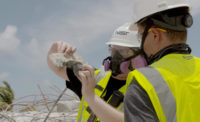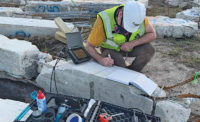Investigations
NIST: Report on Champlain Towers Collapse Delayed to 2026
.jpg?1726248205)
Investigators have tested more than 1,000 concrete and rebar samples from Champlain Towers South.
Photo courtesy R. Eskalis/NIST
A draft report on the 2021 partial collapse of the Champlain Towers South condos in Surfside, Florida that killed nearly 100 people will come in 2026 instead of 2025, say federal investigators compiling the report.
The U.S. Dept. of Commerce’s National Institute of Standards and Technology (NIST) is projecting the later release date of its draft due to complications with interviews, public records access, personnel and complex slab and column testing, all of which has added six to seven months to the report’s planned release, says Glenn Bell, associate lead investigator.
Bell and Judith Mitrani-Reiser, lead investigator, explained the delays and other issues in an update Sept. 12 to the National Construction Safety Team Advisory Committee, saying the revised timeline will see technical work completed by the end of May 2025 with the draft report expected in the spring of 2026. NIST will determine the cause of the collapse and develop science-based recommendations to improve building safety.
In a previous update in March, officials announced the conclusion that the condominium’s pool deck failed more than four minutes ahead of the collapse of the 12-story structure. At that update, the report was expected to publish in the fall of 2025.
The group has worked to minimize impacts to the schedule, but technical and programmatic challenges are extending the timeline, including a six- or seven-month increase in the expected duration of the slab-column testing program, stemming from the complex nature of the eight individual tests that each include the presence or absence of beams in the slab, different types of column support and reinforcing, and whether those pieces were corroded or not and to what degree. That’s now expected to complete by the end of January 2025.
“Our investigation is currently at an inflection point where we are prioritizing and wrapping up our technical activities so that we can fully transition to synthesis and writing, and issue a report for public comment as soon as the science permits,” Mitrani-Reiser says.
One of the committee’s geotechnical team members went on extended leave before leaving the group, Bell adds, increasing the burden on the remaining, small geotechnical team, which also took time to resolve via consulting and contractor options. The committee’s social science program has also seen delays, with complications finding key personnel required to access certain public records, interview drafts taking longer than planned, as well as a six-week pause to interviews surrounding the third anniversary of the collapse.
“The interplay between the highly technical work of the collapse modeling and the human evidence gained in interviews is really valuable and symbiotic,” Glen says, adding that information from one interview can result in reprioritization of subsequent interviews and further technical work.
The delay didn’t sit well with Pablo Langesfled, whose daughter and son-in-law died in the collapse. Speaking during public comment, Langesfeld expressed his disappointment at the delay and the inaction of authorities.
“We don’t need more hypotheses, we need solid and concrete answers,” Langesfeld said. “We need answers now. We need answers today.”
Testing Progresses
Progress is being made, investigators say. Mechanical testing has been completed, including testing of concrete samples and rebar. It's providing a detailed understanding of the strength and deformability of the concrete and reinforcing steel collected from different parts of the structure.
Since March, investigators have completed the wind load history study, defining wind speeds and directions associated with major wind demands impacting the structure over its 40-year lifetime, Mitrani-Reiser says. In May, she adds, investigators worked with local police to move all the evidence to a single warehouse, which was then 3D-scanned to allow virtual walkthroughs of the evidence.
The investigation, to date, has considered more than 300 potential failure points for 25 failure scenarios or hypotheses, says Bell. In March, the committee received tens of thousands more records from the civil litigation.
To date, he says, the committee has reviewed 60 gigabytes of data from about 11,000 files, completed 1,080 laboratory tests and examinations of concrete and rebar samples, 108 tests of soil, groundwater, rock and foundations, and conducted nearly 60 interviews with more than 90 in the works and 10 focus group sessions planned.
“We have learned a tremendous amount that will inform our findings and recommendations,” he says. “However, this progress was achieved in the face of several large, unexpected challenges that we have overcome, but which have slowed some aspects of our investigation.”
Researchers drilled cores of concrete from the building debris, preparing test samples that are then placed in a hydraulic press that squeezes the cores to their breaking points, finding the pressure it takes to reach their failure points, data then used in computer models.
Tension tests of the concrete and rebar are also underway, with cylindrical concrete cores pressed on the curved side, with engineers recording the maximum load at failure. Rebar samples are pulled apart to find how fast the bar stretches before breaking as well as its breaking strength.
Other tests continue to determine condition of cement paste and aggregate constituting the structure’s concrete, as well as how quickly water is able to reach the steel embedded within, and how degraded the steel reinforcements at Champlain Towers were.








